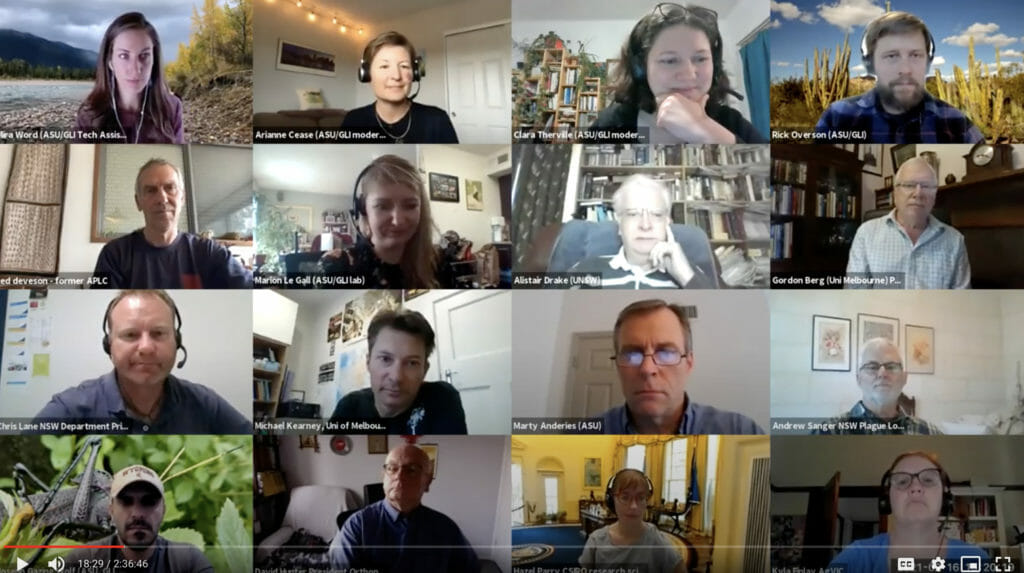The Global Locust Initiative Lab hosted a virtual workshop on locust governance with Australian stakeholders on February 16-17, 2021. This workshop was part of a project supported by the Foundation for Food and Agriculture Research and ASU’s Swette Center for Sustainable Food Systems to understand feedbacks among locust populations, land use, and governance.
This is the second of four planned workshops to identify and address institutional barriers to sustainable locust management. The first workshop took place in February of 2020 in Tucumán, Argentina and focused on governance issues surrounding research and management of the South American locust (Schistocerca cancellata). Both led by Clara Therville, Postdoctoral Scholar, and Marty Anderies, Professor, Arizona State University who study how people govern natural resources.
Over 30 people participated in the Australian stakeholder workshop with representatives from The Australian Plague Locust Commission, The Commonwealth Scientific and Industrial Research Organisation, The University of New South Wales, The University of Melbourne, Department of Primary Industries and other government entities, and more.
Therville designed an online survey that participants filled out prior to the workshop to provide information that was discussed during the workshop. On the first day, participants engaged in a group discussion spanning topics from explaining the factors that contributed to the last outbreak of the Australian plague locust (Chortoicetes terminifera), to identifying the main actors and interactions involved in its governance system. This was followed by breakout groups designed to explore the social map of Australia’s locust and grasshopper management structure. On the second day, participants commented on the maps that emerged from the social network exercise, and discussed the main strengths, opportunities for improvement, and threats for the sustainable governance of the Australian plague locust.
The preliminary results show opposite outcomes from the South American workshop. For the South American workshop, participants highlighted lack of a strong multinational management structure as a significant contributor to the 60-year locust upsurge. For Australia, participants linked their last outbreak (2010-2011) mainly with ecological variables such as weather conditions, while the role played by organizational variables was less important. This result was mostly explained by the maintenance of a robust government structure—The Australian Plague Locust Commission (APLC)—funded even during recession times, and dedicated to locusts surveillance, control, training, resource management, and coordination between local, regional and state response programs. This robust governance structure led to the development and maintenance of knowledge and expertise over the long run, making Australia a historical “world leader in locust management” according to one participant.
However, some issues regarding coordination and responsibility distribution, especially at the local level, were mentioned. In particular, the concern over the role of land-owners in implementing locust surveillance and control, and the long-term promotion of their involvement with upper levels of action was highlighted.
If we take the Australian experience as a representative example, the managers share the same concerns that are expressed around the world: maintaining long-term funding, collaboration, engagement, staff, and experience during quiet times. According to one of the participants, “If plagues become less frequent, for whatever reason, it will be difficult to justify continuing allocation of staff and resources, and preparedness and expertise will decrease.”
This concern about maintenance through locust recessions led to discussion of the role of research and permanent activities such as surveillance, information sharing and training in keeping the staff engaged and the coordination agency relevant. One option was mentioned to grow the realm of APLC impact by expanding the applicability of its current expertise (survey, forecast, response, modelling) to other pests or biosecurity issues, including grasshoppers, or to overseas locust control. The participants actively discussed the advantages and risks of such a strategy—e.g. the “risk of locusts being put on the back burner when APLC is responding to other emergencies”—a situation that has been observed in the past for the desert locust. Lastly, the participants mentioned the need to account for other types of indirect changes that may impact our future capacity to manage locusts, including climate change, increasing environmental constraints on pesticide use, limited alternatives for control, outdated forecasting tools and funding modalities, all of which highlight the need for a permanent adaptation of the locust management system to ensure its relevance in changing times.
Footnote: Special thanks to the following people who made this workshop possible: Chris Adriaansen, Ted Deveson of APLC; Cathy Waters NSW Department of Primary Industries; The ASU team, Douglas Lawton, Arianne Cease, ASU for organizing, recruiting participants. The Global Locust Initiative (GLI) team Rick Overson, Mira Word for logistical support. GLI Lab members who helped facilitate Marion Le Gall, Sydney Millerwise, Maddie Magrino, Joseph Gazing Wolf.
